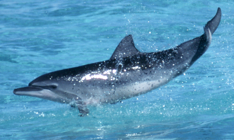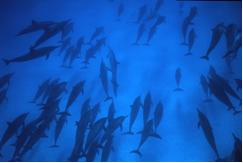Spinner Dolphin
Order Cetacea • Family Delphinidae
Stenella longirostris (Gray)
Status: Not Endangered
Description
The spinner dolphin is a relatively small slender dolphin, with an extremely long, thin nose, or rostrum (longirostris). They average less than two meters in length and weigh about 77 kg (170 lb). Their common name is derived from their habit of leaping up to three meters in the air and spinning up to seven times around their long axis. It is not known why spinner dolphins spin although theories include attempts to remove remoras or other parasites and displays to other dolphins. At least five sub-species of spinner dolphins have so far been described, which differ morphologically from region to region. The Hawaiian form is of the subspecies S. longirostris longirostris, which occurs pantropically. Hawaiian spinner dolphins have a distinctive three-toned coloration. They are dark on the back, with a light grey band on their sides and a white underbelly. There is a dark eye-to-flipper stripe that extends forward from the eye to merge with the dark mouth line and rostrum tip.

Distribution
Spinner dolphins occur throughout tropical and subtropical oceans in relatively large pods ranging from dozens to hundreds of individuals, though groups of over 5,000 have been seen in open ocean environments. In Hawai‘i they are found year-round near islands and atolls throughout the Hawaiian archipelago, where they rest in calm, shallow bays and lagoons throughout most of the daylight hours and forage at night. Although they are seen off all of the Main Hawaiian Islands, they seem to be associated with only four of the Northwestern Hawaiian Islands: Kure Atoll, Midway Atoll, Pearl & Hermes Reef, and French Frigate Shoals. Sightings in offshore waters are not frequent, although some groups of spinner dolphins have been seen in the channels between islands and other offshore waters in the Main Hawaiian Islands. In Hawai‘i they are sometimes found in mixed species schools, with spotted dolphins or humpback whales.
Abundance
The number of spinner dolphins off the Island of Hawai’i alone has been estimated at 1,000-2,000 animals. Research in the farthest Northwestern Hawaiian Atolls suggests populations of a few hundred animals per atoll. No data on current population trends are available.

Photographic-identification of individuals and mark and recapture analyses are utilized to monitor population structure and group dynamics. Photographs are almost exclusively taken of the dorsal fin and surrounding area. Dorsal fin shape, notches (primarily along the trailing edge of the dorsal fin), as well as scratches and scarring on the fins and body are used to identify and catalogue individuals. Scarring is caused by a variety of sources, including other spinner dolphins and cookie cutter sharks.
Movement Patterns
In Hawai‘i, as in other areas where spinners have been studied, groups enter the near-shore, bay or lagoon shallows daily to rest and socialize, returning to deeper offshore waters at night to forage. It is believed that relatively shallow, sandy-bottom and/or sheltered areas, serve as rest habitat, likely providing increased protection against predation from large sharks. During rest, a group of dolphins surfaces and dives synchronously in tight formation with little acoustic or aerial behavior. As dusk approaches, the activity level of the dolphins increases, with higher numbers of animals leaping and vocalizing. As more dolphins come out of rest, the activity level of the group rises, with more dolphins leaping and vocalizing, building into a cacophony of sound as they head toward foraging areas.
Diving Behavior
Spinner dolphins make shallow dives in the near-shore waters during the day. While foraging at night, they move out into open ocean waters of 100-1000 fathoms. Based on the remains found in their stomachs, spinner dolphins are probably feeding at depths from near the surface to as deep as 250 meters.
Acoustic Behavior
Spinner dolphins produce a wide variety of signals: echolocation clicks, “screams”, burst-pulse sounds and harmonic and non-harmonic whistles. Vocalization rate varies between social contexts. It is highest during the night, while dolphins are traveling and engaged in ‘spread’ behavior (a quick dispersal movement pattern in the afternoon). Vocalization rates are much lower in all other social contexts. Whistles are reported to range between 3.9 kHz and 22.4 kHz with durations ranging from 0.10 to 1.82 seconds. Echolocation clicks are broadband with maximum frequencies between 30 kHz and 150 kHz. For perspective, humans hear between 20 Hz and 20 kHz. No quantitative information on the loudness of vocalizations is available. However, burst-pulse sounds range from very quiet to loud enough to be detectable at a range of 1.6 kilometers.
Hearing Range
No audiogram has been produced for spinner dolphins. However, it is likely that their hearing is similar to that of bottlenose dolphins (1 to 150 kHz).
Feeding Habits
In Hawai‘i they feed on fish, shrimp and squid in association with the diel vertical and horizontal migration of the mesopelagic-boundary community (deep scattering layer). For much of the day, prey is located too deep for spinners to reach. As dusk approaches, prey rises nearer to the surface and is therefore more accessible to spinners and other predators. Because food resources are often patchy and wide spread, spinner dolphins work cooperatively in pairs to bunch prey into dense patches and increase their rate of consumption. They follow their prey both vertically and horizontally (inshore/offshore) to maximize the amount of time spent near prey while it is accessible. Recent studies suggest that during their foraging bouts spinner dolphins need to consume an estimated minimum of 1.25 prey items per minute to meet their maintenance energy needs and that these dolphins are time and therefore efficiency limited rather than being limited by the total amount of available prey.
Threats

Because they rest near-shore during the day, Hawaiian spinner dolphins are especially vulnerable to human disturbance. In Hawai‘i free-ranging spinner dolphins have been observed to actively avoid vessels, and short-term behavioral changes have been observed due to approaches by swimmers and kayaks when dolphins are resting. In recent years, efforts by humans to interact with spinner dolphins in Hawai‘i have increased and a recent comparison of the residency of the spinners in Kealakekua Bay on the Big Island shows a decrease in the proportion of days the dolphins occupy the bay. The long-term effects, if any, of these behavioral changes are unknown.
In the eastern tropical Pacific spinner dolphins are often caught and drowned in large numbers incidental to the tuna purse-seine fishing industry. Over the last 20 years the total population in those waters has declined about 80%, from 2 million to 400,000, due to incidental catch. Hawaiian spinner dolphin populations do not receive this pressure.